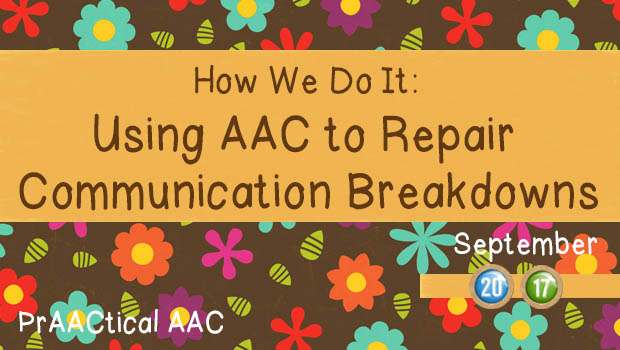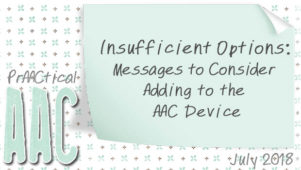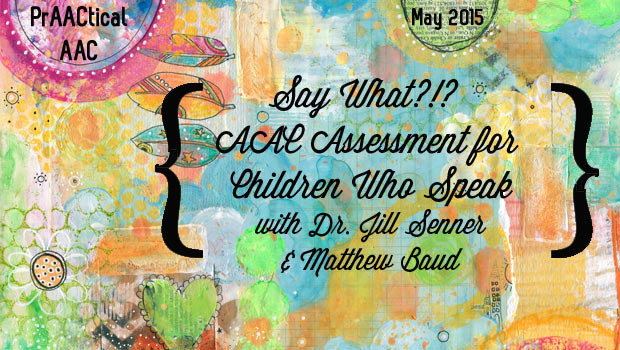How We Do It: Using AAC to Repair Communication Breakdowns

We’ve had many nice comments about the resources shared by AAC SLP Alicia Garcia, clinical lead of the AAC Clinic at One Kids Place, a  children’s treatment centre in northern Ontario. With over two decades of experience in pediatric rehabilitation practice in private and public settings, Alicia’s ideas for how to support AAC learners and their families are tried and true. In today’s post, Alicia shares thoughts and materials for situations in which the AAC is needed to repair communication breakdowns.
children’s treatment centre in northern Ontario. With over two decades of experience in pediatric rehabilitation practice in private and public settings, Alicia’s ideas for how to support AAC learners and their families are tried and true. In today’s post, Alicia shares thoughts and materials for situations in which the AAC is needed to repair communication breakdowns.
::::::::::::::::::::::::::::::::::::::::::::::::::::::::::::::::::::::::::::::::::::::::::::::::
Children with unclear speech not only have different intelligibility levels but also different levels of awareness, focus, and interest on repairing their communication breakdowns. We use different approaches based on how they react and respond when they are not understood.
As a general guideline when a communication breakdown occurs, regardless of the child’s profile, we first try determining the level of urgency or importance of the child’s intended message. If it looks like the message is time-sensitive, we ask questions such as: “Do you need help?” “Do you want permission to do something?” “Do you need me to come with you?” “Can it wait?” If we perceive urgency, we focus on solving the child’s problem, as opposed to addressing the breakdown.
When the child has no awareness that a breakdown has occurred, we try helping him/her notice that they were not understood in a gentle, subtle manner. It is important to focus on maintaining the child’s interest in communicating. At this stage we, partners, take most responsibility to repair the breakdown by:
- Looking for language and speech patterns: learning about the child’s most common conversational topics, typical sound errors; conditions that may help improve intelligibility such as slower or louder speech
- Proving feedback and asking for repetition e.g., I’m sorry, I didn’t get that; Say that again?
- Asking questions: try guessing what the child might be saying e.g., Did you say____?” Is it about _____?
- Using familiar translators: If we know of a peer or family member in close proximity who understands the child, we acknowledge verbally the breakdown and involve the child in finding help e.g., I’m sorry, I don’t quite understand what you’re telling me; let’s find Johnny
Some children may have the awareness that they are not understood but don’t have enough focus or attention to use AAC to repair the breakdown. In these cases we try:
- Introducing AAC by modeling during natural, incidental communication: when we hear a potential breakdown (i.e., we know what the child is communicating but other people may not), we model by pairing what the child is saying with a picture, a gesture or a sign
- Prompting and expecting the use of AAC tools only during scripted, game-type activities (as opposed to natural face-to-face exchanges). For example, we practice using a device during barrier games where the partner and child take turns describing and guessing pictures or objects, or practice pointing to pictures during functional scripts such as pretending going shopping, ordering at restaurant, meeting new people, answering teachers’ questions
Some children seem to have some level of awareness and good focus but no interest or desire to repair their communication breakdowns. We focus on encouraging engagement, in making sure the child understands that we are interested in what they have to say. We try finding out why the child has no interest in repairing breakdowns and try developing a consistent clarification process for partners to implement. We focus on promoting opportunities to have the child experience payoff of successful repairs.
Tips to Teach Children How to Use Augmentative Communication for Clarification Purposes
Children whose speech is not clear frequently have a difficult time learning to use pictures to clarify the messages they are trying to communicate. Just having a device or pictures available is not enough. They need training to learn to use these tools to make themselves understood. The following tips are recommended when introducing a clarification system (device, picture book etc):
- Teach the child to respond to the question: What is it about? The child needs to understand that just repeating what he said does not help us understand him better. We start teaching the child to respond to this question by MODELING the phrase “talking about” many, many times during the day. For example, when the teacher talks about how cold it is today, the communication partner says: “Ms. Smith is talking about the weather” and then looks for the picture of weather on the device
- Spend time with the child learning the location of the pictures on the AAC system. Both, communication partner and child need to be able to find pictures within categories in a relatively fast manner. You need to spend time with the child exploring where pictures are located. E.g., applesauce is in the FOOD and DRINKS button, swimming is in the ACTIVITIES button, mom is in the PEOPLE button. Partners should do the navigation out loud e.g., “I’m trying to find the word HOCKEY…. Let’s see… is it here, under Activities?… No, it’s not… Maybe it’s here, under Sports… YES, I see it here”
- Until she child learns to navigate the AAC system, partners should take ownership of repairing the communication breakdown. Partners should hold the AAC system in front of the child and point to pictures of categories while asking questions such as “Are you talking about… someone?(PEOPLE)… something you did? (ACTIVITIES) … a place you are going (PLACES)? Partners should gradually fade the level of support until the child is comfortable finding pictures to repair communication breakdowns on his own
- Communication partners need to be become more systematic and aware of their questions and requests for clarification. It is recommended to follow a pattern of steps. For example, asking the child to:
- Slow down (encourage him to keep trying)
- Say it in a different way (i.e., “tell me more”)
- Show with his hands or body (by acting it out or pointing at things in the environment) or Draw it
- Use the device
- Other valuable clarification resources are the iPad Calendar and Camera Roll:
- CAMERA ROLL: encourage the child to take photos or objects and events representing activities he has participated in. Photos allow the child to initiate conversations – especially with less familiar partners. Have the child take photos from special places he goes (movie theatre, restaurants), people he encounters, activities and events he participates in. Encourage the child to take photos of books and characters he likes to talk about. This will be a way for the child to have contextual cues readily available. Add in photos from new units at school that the child has difficulty saying e.g., dinosaurs, volcanoes, insects. Model using the camera roll. You can add labels to pictures while keeping them in the camera roll using the app PhotoName.
- CALENDAR: it keeps family and school partners informed about new or interesting topics that the child may want to talk about. It also lets the child comment on activities in which he participates in regularly. The app Photo 365 allow partners to enter photos on a blank calendar grid.
You can download Alicia’s handout on this topic and a questionnaire for communication partners here.
Filed under: Featured Posts, PrAACtical Thinking
Tagged With: Alicia Garcia, communication breakdown, repair, speech intelligibility
This post was written by Carole Zangari





1 Comment
I can respond to students better when I know what they are trying to say